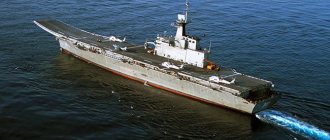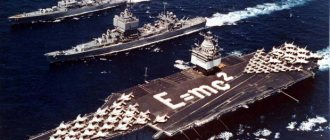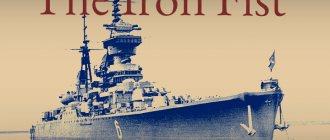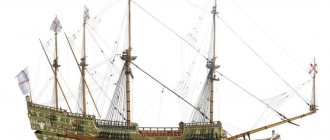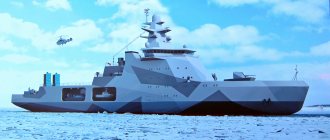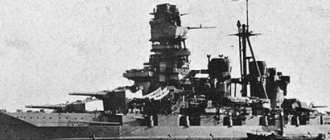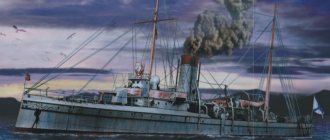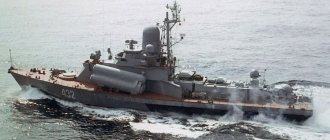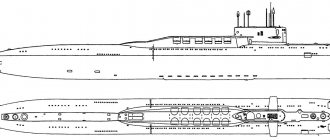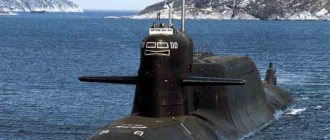Author: IdIuaM
16 June 2022 12:50
Tags: navy ships fleet
16336
39
10 best examples of naval equipment of all times. Power, beauty and courage. Each of the ships presented here performed a lot of outstanding feats. They forever covered their decks with laurels of glory and made their enemies come out with drops of sticky fear.
0
See all photos in the gallery
The strongest of the strongest. They could single-handedly change the situation in the theater of operations and question all the previous canons of naval combat. They cut the map of the world like rusty scissors cutting tin roofing. They fought and won. And when they lay down on board, tormented by enemy fire, they did not lower the flag and, to the sounds of the anthem, went under the water... and for another half a minute shells flew towards the enemy, fired by the already dead crews of the sunken ship. Forward to the past or back to the future? The rating positions are conditional - each of the ships has already earned its place in history and does not need vulgar assessments from “armchair experts”. All the author of this material wanted was to present to your attention 10 exciting stories that can cheer up anyone who cares about the Navy.
The largest sailing warships
For thousands of years, sailors were forced to make do with only two propulsion devices - oars and sails. Over time, the size of the ships gradually increased, but this process was slow.
The first truly large sailing ships appeared in the 14th century in Portugal. These were the so-called carracks, which differed from the caravels that preceded them by much better seaworthiness and a unique hull shape with an elevated stern. Not all of them were of significant size, but the English carrack Grace Dew, built in 1418, already had a displacement of 2,750 tons - simply enormous at that time.
Mass construction of large military sailing ships began almost a century later, when cannons became so advanced that it became possible to place them on a ship. Thus, in 1510, the Mary Rose carrack was launched in England, with 78 guns installed on board. After 24 years, she was slightly rebuilt, adding 13 more guns, making the Mary Rose the most powerful warship of that era.
Karakka "Mary Rose", a powerful ship of the early 16th century
Until the end of the 16th century, the seas were ruled by carracks and the galleons that replaced them. In 1604, England introduced a kind of standardization, dividing all warships into ranks (later rate) depending on the number of guns. Around the same time, the construction of sailing battleships began. They were much more maneuverable and easier to control than galleons, but their main quality was the ability to use linear tactics (hence the name - battleships).
Already in 1637, the British launched a new “champion” - the famous battleship HMS Sovereign of the Seas. One hundred and two cannons were located on its three decks. “Lord of the Seas” is, if not the largest, then the most expensive and most heavily armed ship. As for the displacement, it reached 1522 tons.
The naval arms race that unfolded between the leading countries of Europe starting in the 17th century (and under Peter the Great, Russia also joined this competition) led to the appearance of increasingly larger wooden sailing battleships. The number of guns gradually increased to 120-130 and even 144 pieces, with a constant increase in their calibers, and the displacement of such ships came close to the 5,000-ton mark.
After the Battle of Trafalgar, for some time the most powerful warship in the world was the Russian 130-gun combat sailing ship "Grace".
Russian sailing 130-gun battleship "12 Apostles"
"Atago"
A type of guided missile destroyer in the Japanese fleet. These are improved and enlarged ships of the Kongo class. A total of 2 destroyers of this type were built; they are equipped with the Aegis information and control system. They have improved habitability and combat capabilities, and have a hangar for a helicopter, whereas previous modifications only had a helipad, without supporting equipment.
The Atago is armed with Japanese-made anti-ship missiles, rapid-fire anti-aircraft guns, and torpedo tubes. The Atago could theoretically carry Tomahawk cruise missiles, but in accordance with the country's constitution, the ship does not have them.
"Arleigh Burke"
American destroyers of the 4th generation. As of 2010, the Arleigh Berks are representatives of the largest series of ships with a displacement of over 5,000 tons (89 units are planned to be built, 69 have already been built). Considering that the construction of destroyers is not going fast, it is unlikely that any other country will be able to break this record in the near future. In addition to the American fleet 4, several modified vessels are in service in the Japanese fleet.
"Daring/Type 45"
A type of modern guided missile destroyer that has been built for the Royal Navy since 2003. There are 6 ships in service, the last one was launched in 2013. “Daring/Type 45” is by far the largest ship of this type built for the British fleet. It is armed with navigation and radar systems, guns and anti-aircraft guns, missiles, and an anti-torpedo defense system. The aviation group consists of 1 helicopter.
"Horizon"
A series of frigates, 2 ships each, are in service with the Italian and French navies. The size of the Horizons corresponds to destroyers, not frigates, they are 150 m long, 200 m wide, 6,700 tons of displacement, and can travel up to 7,000 miles at a speed of 18 knots. It is armed with radar, radio-electronic systems, anti-aircraft kits, missiles, torpedoes and mines, and a Merlin EH101 HAS helicopter.
"Akizuki"
A series of 12 Japanese destroyers from World War II. These were the most advanced ships of this type in the Imperial Japanese Navy. They were developed to accompany aircraft carrier formations. It was planned to build up to 40 identical ships, but only 12 units were created before the end of the war. Ready-made destroyers actively took part in battles in the Pacific Ocean. After the end of the war, some of the destroyers were scrapped, others went to the winners. In the USSR and China, 2 ships were operated until the 1960s.
6) Cigarette AMG Electric Drive Concept
The fastest electric boat in the world
Maximum speed (Km-h / Kn-knot): 160 km.h / 87 kt.
Mercedes-AMG has developed an electric speedboat that uses 12 electric motors with a total power of 2,220 hp. Environmentalists should be very glad that such a rare sea vessel causes virtually no harm to marine nature.
"King Sejong"
Modern destroyers with guided missiles, produced in the amount of 2 units, are used in South Korea. The design is similar to the Arleigh Burke. Another ship has been built, and 3 more identical ships are planned. Equipped with the Aegis system, artillery and anti-aircraft installations, radar systems, mines, missiles and torpedoes.
"Zamvolt"
A new series (32 units are planned) of destroyers of the American fleet, the purposes of which include mainly attacks on land and coastal targets. The main ship's weapons are 80 Tomahawk missiles, plus artillery systems. Thanks to the equipment, Zamvolt can perform missions to support ground forces. It is equipped with a promising system that can control all weapons at once. The advantages include stealth; the installed means reduce it by 50 times compared to previous variations.
Destroyers are used for possible naval combat with enemy ships, submarines, aircraft and missiles. They can also perform other tasks - escort and guard ships, carry out patrol and reconnaissance services.
"Calcutta"
A series of 3 units built using Stealth technology. Designed, manufactured and operated in India. The largest destroyers in the Indian Navy. Developed on the basis of Project 15 “Delhi”, they differ from their predecessors in greater combat effectiveness due to an improved design, the presence of cruise missiles to destroy ground targets and because they are equipped with powerful radars.
Kongo-class destroyer
The Japanese Navy, faced with the mission of defending the country against North Korean short- and medium-range missiles, commissioned four Kongo- .
The ships are replicas of the American Burke . Kongo and her three sisters, Kirishima , Myoko and Chokai , are each 178 meters long and can carry a full load of 9,400 tons. Each was built with ninety of the same vertical launch silos as the Ticondero- . The Kongo class is very similar to its American ancestor, but the Japanese vehicle still has differences: a five-inch Oto-Melara cannon, LM-2500 gas turbines manufactured under license from IHI Japan, and locally produced sensors and electronics.
Kongo- class destroyers are designed to protect Japan. the SM-3 missile interceptor . Two destroyers can protect most of the country from ballistic missiles. Two Congos are constantly at sea for this purpose.
055 destroyers are Chinese ships whose construction began back in 2014. An extension of the 052 class, these ships are larger and more capable than any other ship of their class, and are likely to provide stiff competition to the Ticonderoga .
The Type 055 ships are 180 meters long, making them longer than the Ticonderoga , and weigh approximately over ten thousand tons. Like their American counterparts, the Type 055 are likely designed to serve as bodyguards to China's carrier fleet, with the ability to take on submarines and ships if necessary.
One feature that makes the Type 055 on this list: a total of 112 vertical launch silos, each of which can carry YJ-18A and YJ-100 , land attack cruise missiles, or HQ-9B long-range air defense missiles. HHQ - 10 missiles , similar to the NATO Rolling Body Missile (RIM-116) H/PJ-11 close-in combat systems , similar to the US Mark 15 Phalanx CIWS .
China launched two Type 055 ships simultaneously in July 2018, with a total of six ships in varying states of completion. China is believed to be planning to build eight destroyers.
"The fastest destroyers"
1st place "Le Terrible"
The destroyer was originally from France and reached a speed of 45 knots. It was the same as that of the Italian Navigatori, but when measured in kilometers per hour, the Frenchman was faster and it was he who got into the Guinness Book of Records. Le Terrible showed its maximum speed in 1935, and its displacement was 800 tons more than that of its Italian competitor and amounted to 3251 tons. It was driven by four steam boilers, as well as two turbines. As a result, producing a power of 100 thousand horsepower.
At the beginning of the 20th century, many engineers began to design "leaders", a type of destroyer that had outstanding speed. For this reason, they occupy all 3 places in the list of fast movers. You cannot find any active destroyer here.
2nd place “Navigatori”
The Navigatori type was originally from Italy and 12 of these ships were built. Back then they were called not “leaders”, but “scouts”. They were born from 1929 to 1931, at the same time as the previously described destroyer from England. The displacement of the Navigatori was only 2,400 tons, but the speed was developed to 45 knots. The ship encountered shell scattering and despite the fact that it was not classified as a failed project, it did not even survive until World War II and in 1938 the entire type of equipment was decommissioned.
3rd place "HMS Codrington"
This list is opened by a representative of the British Navy. It would be naive to believe that no island nation was building some of the best ships, since it was by World War II that England and Germany were the main participants in water battles. So it was built in 1929, 10 years before the biggest war of our time. It was extremely fast, but not very maneuverable; its speed at that time was 40 knots. But the production of this vessel can well be called a failure, because the construction price tag was very high, and even light cruisers could more easily endure the difficulties imposed on it.
